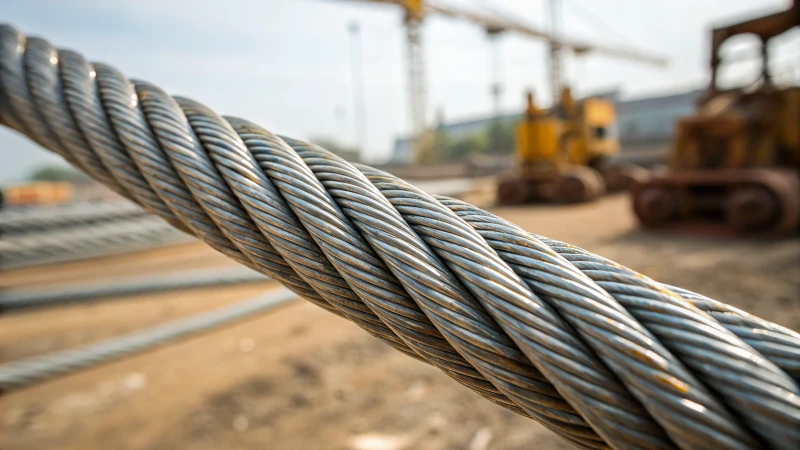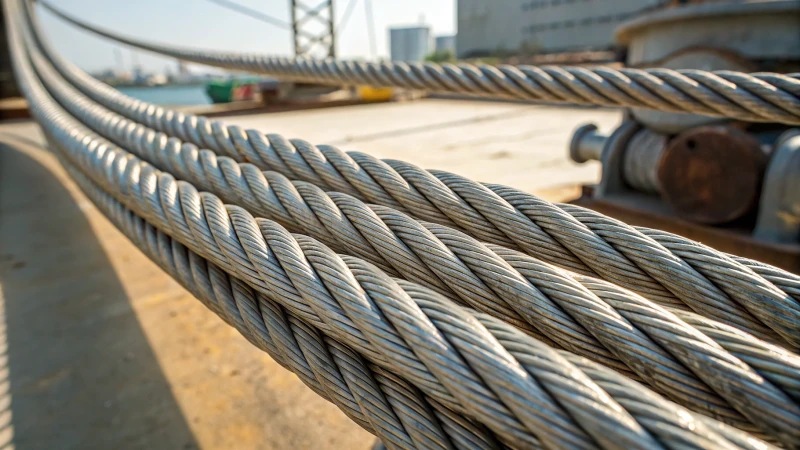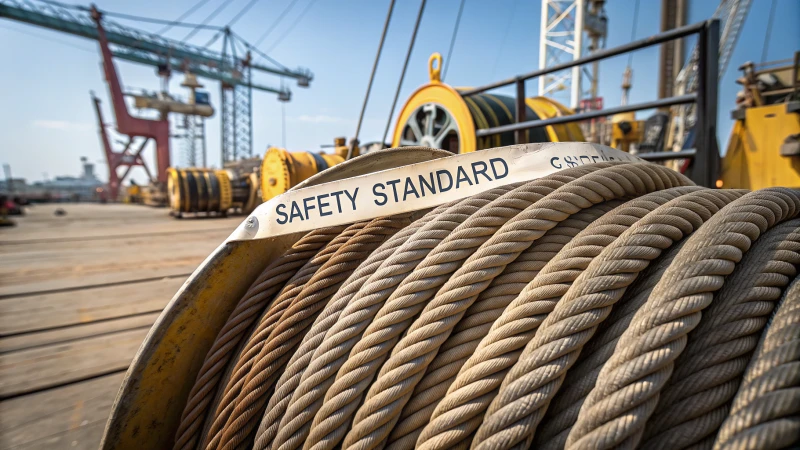
Picture this: you're responsible for heavy machinery, and the safety net is a steel wire rope.
Steel wire rope strength for heavy machinery hinges on its tensile strength and breaking load capacity. High tensile steel is essential to ensure durability and safety under extreme loads, often supporting weights of 100 tons or more.
Imagine standing on a construction site, surrounded by towering cranes and the rhythmic clatter of machinery. It's crucial to trust that the steel wire ropes in use are not just strong but virtually unbreakable. The secret lies in the technical specs like tensile strength and breaking load capacity—terms that become your best friends when ensuring safety and efficiency. High tensile steel is the go-to choice, designed to withstand the brutal forces at play, sometimes lifting weights that could rival a hundred elephants! But it’s not just about raw power; it’s about smart engineering that adapts to ever-evolving industry needs. Dive deeper with me into the world where material choices meet cutting-edge innovations, and let’s uncover how these elements weave together the unyielding fabric of industrial strength.
Steel wire ropes must support weights over 100 tons.True
Steel wire ropes are designed to handle extreme loads, often exceeding 100 tons.
High tensile steel is rarely used in wire ropes for heavy machinery.False
High tensile steel is commonly used to ensure durability and safety.
How Is the Breaking Load of Steel Wire Rope Determined?
Ever wondered how much weight a steel wire rope can really handle? It's a question that keeps me up at night, especially when safety is on the line.
To determine the breaking load of steel wire rope, I look at the rope's diameter, material tensile strength, and construction type. The calculation often follows this formula: Breaking Load = Cross-sectional Area x Tensile Strength.

Factors Affecting Breaking Load
I remember the first time I had to choose a steel wire rope for a project. It was like diving into a world of numbers and specifications. The diameter of the rope is crucial—bigger ropes can carry more weight. Imagine using a thin rope for a giant crane; it just wouldn't cut it.
And then there's the material composition. High-tensile steel is like the superhero of materials, strong and reliable. I once learned that ropes made from this stuff can take on loads that would make other materials snap.
Calculating Breaking Load
The math isn't too scary once you get the hang of it. The formula:
Breaking Load = Cross-sectional Area x Tensile Strengthbrings back memories of late nights poring over data sheets. The cross-sectional area is all about the rope's diameter and how it's built. When I first calculated this for a 12mm rope with 1770 N/mm² tensile strength, it was a lightbulb moment, realizing how these numbers translate into real-world strength.
Importance of Standards and Testing
Standards like ISO 24081 are there for a reason, ensuring we don't just take manufacturers' word for it. These guidelines feel like a safety net, making sure ropes are tested and can handle their rated loads. I've seen procurement managers like John and Emma breathe easier knowing their choices meet these standards.
Practical Applications in Industry
In places like mining or construction, theory meets practice. Ropes are tested under tough conditions to see if they live up to their claims. Using something like a hydraulic test machine2 can be eye-opening—watching ropes stretch until they fail provides real insight into their limits.
Tables for Quick Reference
For those days when you need to make quick decisions, this table is a lifesaver:
| Diameter (mm) | Approx. Breaking Load (kN) |
|---|---|
| 10 | 60 |
| 12 | 80 |
| 14 | 110 |
| 16 | 140 |
It's a handy guide for when folks like Klaus or Sarah need to decide which ropes to buy without spending hours crunching numbers.
Larger diameter ropes support greater loads.True
Larger diameters increase the cross-sectional area, enhancing load capacity.
Breaking load is independent of material composition.False
Material composition affects tensile strength, influencing the breaking load.
Which Materials are Ideal for High-Performance Wire Ropes?
Choosing the right material for wire ropes feels like picking the perfect ingredient for a recipe—it determines the success of the whole operation. Let’s dive into the world of wire ropes and see which materials stand out.
High-performance wire ropes are ideally made from stainless steel, galvanized steel, or high-carbon steel. Stainless steel excels in corrosion resistance, galvanized steel offers cost-effectiveness, and high-carbon steel provides superior strength.

I remember the first time I had to decide on materials for wire ropes. It felt like navigating a maze of choices, each promising something different. Through trial and error, I realized the importance of understanding each material's unique strengths and weaknesses.
Stainless Steel Wire Ropes
Stainless steel wire ropes became my go-to for maritime projects. Their resilience against corrosion was like having an unwavering ally in the face of salty sea air. They remind me of the time I worked on a project near the coast where rust was our constant enemy. Stainless steel didn’t just survive—it thrived.
| Property | Benefit |
|---|---|
| Corrosion Resistance | Ideal for marine use |
| Longevity | Reduces replacement needs |
Using stainless steel3 in environments with high salinity ensures longevity and performance with minimal maintenance.
Galvanized Steel Wire Ropes
Galvanized steel ropes are like the budget-friendly heroes of construction sites. I once found myself stretched thin on a project budget, and galvanized steel came to the rescue without compromising on durability. It’s that perfect blend of affordability and reliability that makes it a solid choice.
For those comparing materials, galvanized wire ropes4 provide a balance between cost and durability.
High-Carbon Steel Wire Ropes
When it comes to handling heavy machinery, high-carbon steel ropes are in a league of their own. I recall the high-stakes environments in mining operations where these ropes had to bear massive loads. Their exceptional tensile strength was reassuring in moments where failure wasn’t an option.
Their strength-to-weight ratio is unparalleled, which is why high-carbon steel5 is often chosen when maximum load capacity is required.
Comparing Key Properties
Through these experiences, I've learned that choosing the right wire rope material is about matching the environment with the specific strengths of each material:
| Material | Corrosion Resistance | Strength | Cost-Effectiveness |
|---|---|---|---|
| Stainless Steel | High | Moderate | High |
| Galvanized | Moderate | Moderate | High |
| High-Carbon | Low | High | Moderate |
By understanding these materials' properties, procurement managers can make informed decisions tailored to their specific industry needs.
Stainless steel wire ropes resist corrosion in marine settings.True
Stainless steel is renowned for its corrosion resistance, ideal for maritime applications.
High-carbon steel wire ropes have low tensile strength.False
High-carbon steel is known for exceptional tensile strength, ideal for heavy loads.
How Do Safety Standards Impact Your Wire Rope Choice?
Choosing the right wire rope isn’t just about strength; it’s about ensuring safety and compliance in every lift.
Safety standards guide wire rope selection by setting criteria for breaking load, material quality, and inspection protocols. Adhering to these standards ensures the rope's durability and safety, reducing the risk of equipment failure in high-stress situations.

Understanding Safety Standards in Wire Rope Selection
When I first delved into the world of industrial procurement, the intricacies of safety standards felt overwhelming. But as I learned, these standards are the backbone of choosing the right wire rope for any application. Key organizations like OSHA and ISO set these guidelines to ensure wire ropes perform safely and reliably. The last thing anyone wants is a catastrophic equipment failure due to a lapse in meeting these crucial standards.
Breaking Load and Tensile Strength
I'll never forget my first major project where we needed wire ropes that could handle up to 100 tons. The breaking load capacity was a critical factor—essential for the heavy machinery we were using. Evaluating tensile strength wasn't just a box to tick; it was about ensuring the safety and success of our operation. Selecting the right rope6 meant digging deep into these specifications to meet our stringent safety requirements.
Material Specifications
I remember being in a meeting where we discussed the importance of material specifications. Steel wire ropes were our go-to because of their unmatched tensile strength and resistance to harsh conditions. It’s not just about picking a durable rope; it’s about choosing one that won’t let you down when it matters most. Following material standards is key to maintaining that integrity under stress.
| Material Type | Key Features | Use Case Example |
|---|---|---|
| High Tensile | Superior load-bearing capacity | Heavy lifting in construction |
| Galvanized | Enhanced corrosion resistance | Marine applications |
| Stainless Steel | Durability and wear resistance | Mining and industrial settings |
Inspection and Maintenance Protocols
Regular inspections became a routine I couldn’t ignore after witnessing a near-miss due to a worn-out rope. These protocols are lifesavers, catching wear or damage before they escalate into disasters. Understanding these inspection requirements7 influences which ropes I choose, favoring those that are easier to maintain and promise a longer lifespan.
Design Factors
Wire rope design factors, such as diameter and construction type, are more than technical details—they're pivotal in matching the right rope to the task at hand. Different designs offer varying flexibility and strength, crucial for specialized tasks like hoisting in heavy machinery. Understanding design considerations8 has taught me that safety and operational efficiency go hand-in-hand.
By grasping these safety standards, I’ve learned how to make informed decisions that not only align with regulations but also optimize performance, ensuring each project is both successful and safe.
OSHA defines criteria for wire rope selection.True
OSHA provides safety standards that guide the selection of wire ropes.
Stainless steel ropes are unsuitable for mining.False
Stainless steel is suitable for mining due to its durability and wear resistance.
What Are the Latest Innovations Boosting Steel Wire Rope Durability?
Remember the first time you saw a steel wire rope in action, lifting something impossibly heavy with ease? It's amazing how these ropes have evolved, isn't it?
Recent innovations in steel wire rope durability include using high-tensile steel, applying corrosion-resistant coatings, and integrating smart sensor technologies. These advancements significantly increase strength, minimize maintenance needs, and extend wire ropes' lifespans.

Advanced Materials and Manufacturing Processes
I remember when I first heard about using nanotechnology9 in steel wire ropes. It was like stepping into the future! With high-tensile materials, these ropes are now stronger than ever, capable of handling immense loads without losing their integrity. Imagine a rope that could bear the weight of several elephants stacked on top of each other—it's that strong!
Corrosion-Resistant Coatings
Working in environments where corrosion is a constant threat—like near the sea or underground mining operations—has always been challenging. However, thanks to innovations like galvanization10 and polymer coatings, we can now protect our ropes from rust and environmental wear. I once saw a rope that had been used in such harsh conditions for years, and it still looked almost new thanks to these coatings.
| Coating Type | Key Benefits |
|---|---|
| Galvanization | Excellent rust protection |
| Polymer Coating | Enhanced weather resistance |
| Nano Coatings | Ultra-thin, highly effective against corrosion |
Smart Sensor Technologies
The integration of smart sensors into steel wire ropes was a game-changer for me. These sensors provide real-time data on tension and wear, allowing us to predict maintenance needs before something goes wrong. It's like having a crystal ball for rope health! Using IoT technology11, we can now monitor these ropes remotely and get alerts if something's amiss.
Improved Design and Engineering Techniques
I have seen how computer-aided design tools have transformed the engineering of steel wire ropes. With optimized strand configurations, these ropes endure less friction and wear over time. Using finite element analysis12, engineers can now predict how ropes will react under different conditions, leading to designs that perform better over time.
Hybrid Composite Ropes
Combining steel with synthetic fibers was another breakthrough I found fascinating. These hybrid ropes offer the best of both worlds—the strength of steel with the flexibility and lightness of synthetics. They're especially useful in offshore applications13 where reducing weight is crucial without sacrificing strength.
These innovations make steel wire ropes not just stronger but smarter and more reliable, meeting the intense demands of modern industry head-on.
Nanotechnology enhances steel wire rope strength.True
Nanotechnology is used to create stronger steel alloys, enhancing rope durability.
Hybrid composite ropes are heavier than traditional steel ropes.False
Hybrid ropes combine steel with lighter synthetic fibers, reducing weight.
Conclusion
Steel wire ropes for heavy machinery must possess high tensile strength and breaking load capacity, often exceeding 100 tons, ensuring safety and efficiency in demanding industrial applications.
-
Explore ISO 2408 standards to understand compliance requirements for steel wire ropes. ↩
-
Discover how hydraulic testing ensures steel wire ropes meet safety and performance standards. ↩
-
Find out why stainless steel is ideal for high-salinity environments due to its rust resistance. ↩
-
Learn why galvanized steel wire ropes are cost-effective and durable for construction uses. ↩
-
Explore the superior tensile strength of high-carbon steel wire ropes for heavy-duty applications. ↩
-
Explores guidelines for selecting wire ropes that meet specific breaking load requirements. ↩
-
Details routine inspection protocols essential for maintaining wire rope safety. ↩
-
Describes design considerations crucial for selecting safe and efficient wire ropes. ↩
-
Discover how nanotechnology enhances the tensile strength of steel, making it more durable and efficient for heavy-duty applications. ↩
-
Learn how galvanization provides superior rust protection, extending the lifespan of steel wire ropes used in harsh environments. ↩
-
Explore how IoT technology enables smart monitoring of steel wire ropes, enhancing safety and maintenance efficiency. ↩
-
Understand how finite element analysis helps optimize rope design for better performance under various conditions. ↩
-
Find out how hybrid composite ropes combine strength and flexibility for improved performance in offshore applications. ↩

